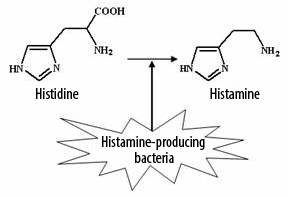Tokyo Food Safety Information Center » Good things to know » Food poisoning caused by histamine
Food poisoning caused by histamine
Did your tongue tingle or did red hives appear on your face after eating fish?
If it was not caused by a food allergy, likely it was food poisoning caused by a chemical compound called histamine.
1 Histamine food poisoning
Symptoms
Most commonly, the symptoms include a flushed face, especially around the mouth and earlobes, hives, headache, vomiting, and diarrhea within one hour after eating. Severe cases can lead to difficulty of breathing or unconsciousness, however no deaths have been reported.

Foods that cause food poisoning
Principal foods that cause this type of food poisoning are red meat fish and its processed products, which contain an amino acid called Histidine. Among cases reported in Tokyo from 2012 to 2021, the most common cause was yellowtail, followed by sardine, mahi-mahi, and pacific saury.
In other countries, it has also occurred in connection with chicken meat, ham, or cheddar cheese.
For more information on actual food poisoning cases, click here (Japanese).
2 Points to prevent histamine food poisoning
Once histamine is produced, it is not possible to break it down with heat during cooking.
Therefore, it is crucial to inhibit the growth of histamine-producing bacteria and enzyme action to prevent the production of histamine. Temperature management from the raw material stage (in the case of fish, that means the moment of death) until eating the final product is important.
Food Poisoning Prevention Leaflets are here (Japanese)
For consumers
- Store raw fish in a refrigerator promptly without leaving it out at room temperature.
- Remove the gills and entrails from fish as soon as possible after purchase because histamine-producing bacteria exist particularly in the gills and digestive tracts.
- Consume as soon as possible even when being stored in a refrigerator.
- Avoid consuming fish that may have lost freshness.
- Cold storage is recommended even for processed products of red meat fish including dried fish.
- When defrosting frozen red meat fish, defrost at as low a temperature as possible (e.g., defrosting in the refrigerator) in a short time. Refrain from repeated freezing and defrosting.
- Higher histamine levels can cause a tingling sensation in the mouth when you eat.
- If you feel an unusual tingling sensation on your lips or the tip of your tongue, dispose of the food without further tasting it.
For business operators
Ensure sanitation management as below to prevent food poisoning caused by histamine.- Refrigerate or freeze raw fish immediately when storing.
- When defrosting or processing fish, ensure low temperature control.
- Do not use fish that has lost its freshness.
- Use raw materials under proper temperature control such as by purchasing only from reliable suppliers.
3 Difference from food allergies
Food poisoning caused by histamine has similar symptoms as food allergies, however, it is not associated with food allergies, since it is caused by consuming histamine formed in food. It is possible for anyone to suffer from histamine food poisoning.
4. Histamine-producing bacteria
Histidine, which is normally found in red meat fish (e.g., tuna, yellowtail, saury, mackerel, sardine) breaks down to histamine by the activity of enzymes produced by histamine-producing bacteria. It is believed that food poisoning may appear as a result of consuming 100 mg or more of histamine. Some histamine-producing bacteria exist in sea water and they may already attached to the bodies of fish at the time of fishing.

Figure Mechanism of histamine production
There are a variety of histamine-producing bacteria, but they are generally characterized by the following.
| ◇ | They are broadly categorized into 2 types – marine bacteria which live in ocean water, and bacteria from the Enterobacteriaceae family which live in the digestive tracts of humans and animals. |
| ◇ | Ocean-caught fish may contain histamine-producing marine bacteria at the time of their capture. Photobacterium phosphoreum, P.damselae, etc. |
| ◇ | Enterobacteriaceae histamine-producing bacteria can contaminate fish when they are processed after capture. Morganella morganii, Raoultella planticola, etc. |
| ◇ | The temperature at which these bacteria most easily grow depends on the type of bacteria: some can grow between 25 and 40℃ (mesophilic bacteria), while others can grow between 0 and 10℃ (psychrophilic bacteria). |
| ◇ | As psychrophilic bacteria can multiply even when refrigerated, storing raw and dried red meat fish for long periods of time in a refrigerator can result in histamine being generated. |
References
- Manual of Food Poisoning Prevention 2nd Edition (Japan Food Hygiene Association)
- “Food poisoning caused by histamine” (Japanese), Ministry of Health, Labour and Welfare website